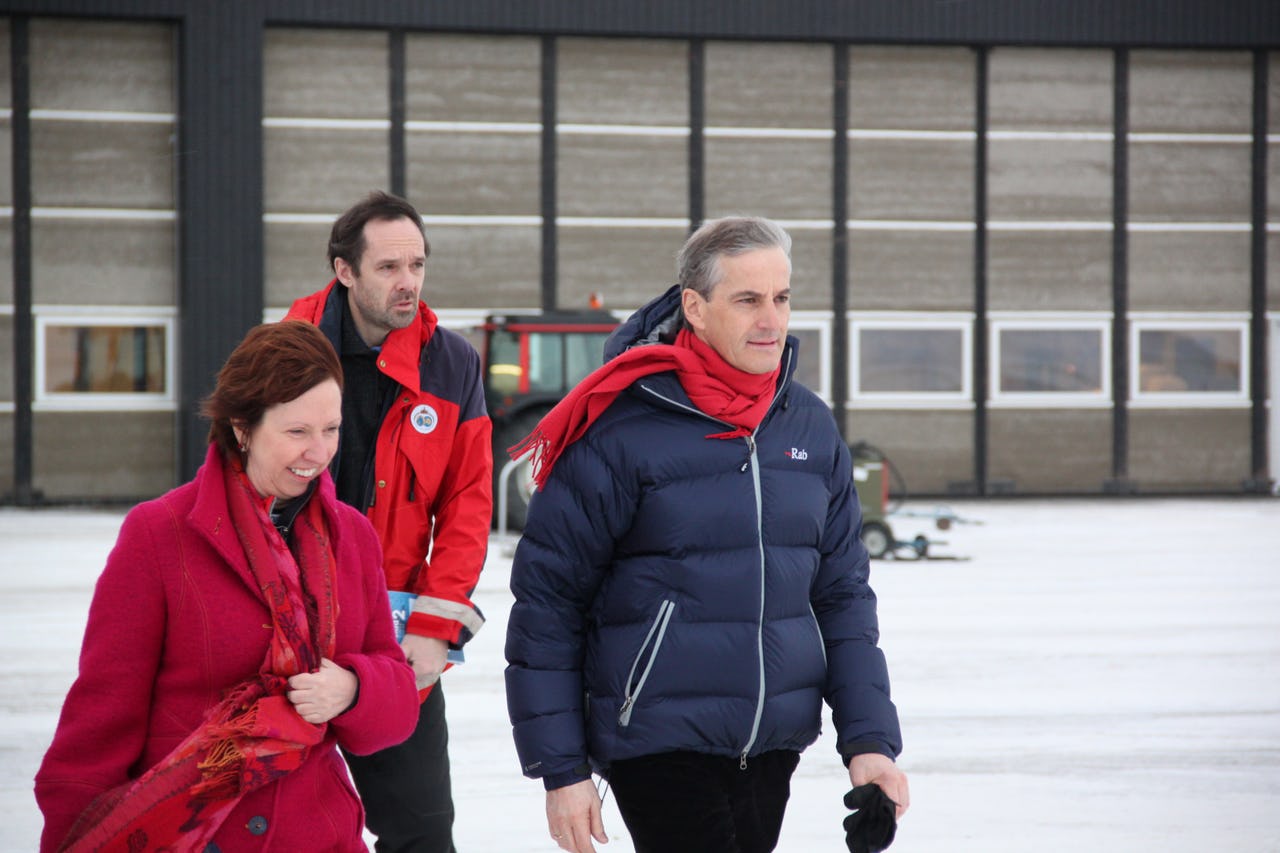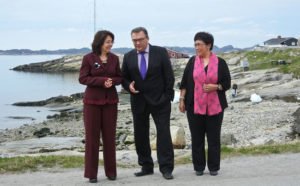Further Steps Towards a Comprehensive EU Arctic Policy: Is the EU Getting There?

EU High Representative Ashton and Norwegian Foreign Minister on Svalbard, 8 March 2012. Photo: Mission of Norway to the EU
On July 3rd the European Commission (EC) and the High Representative of the European Union for Foreign Affairs and Security Policy issued, after much delay, the European Union’s up-to-date communication regarding the development of a coherent and comprehensive European Union (EU) policy towards the Arctic region (JOIN(2012) 19 final). The two-part report proposes both a set of building blocks for the EU’s constructive engagement in the Arctic and outlines the progress and policy steps taken since the EC’s first communication in 2008. It further highlights the EU’s future Arctic engagement along three key categories: “knowledge, responsibility and engagement”.
The Joint Communication was much anticipated not only by relevant Arctic actors, e.g. the A5/A8, but also internally by several Members of the European Parliament (EP). The EC’s first communication was criticized because of the language used, which intimidated certain Arctic actors to some extent. In the first communication, the EU’s proposed intentions were rather blurry and were seen as intervening in Arctic states’ issues. Regarding the new Communication, an EC official recently stated that the Commission’s present responsibility is to better clarify the EU’s Arctic role: “The European Union has the duty to put its cards on the table and reveal its actual intentions.”
Was this self-imposed obligation achieved?
The central point of the Communication remains in essence the same: “The European Union should step up its engagement with its Arctic partners to jointly meet the challenge of safeguarding the environment while ensuring the sustainable development of the Arctic region” (p. 2). In other words, the question remains how to handle the balancing act between economic development and environmental protection in an internationally cooperative manner.
Indicating the growing strategic importance of the Arctic region, the Joint Communication highlights the (perceived) important role of the EU in supporting successful cooperation in an already peaceful and safe environment. Further, it portrays the EU as the world’s strongest proponent of international efforts to fight climate change, a major destination of resources and goods from the Arctic and a triple (and potentially quadruple) member of the Arctic Council (AC), via its member states Denmark, Finland and Sweden.1)
Outlining several elements of the EU’s Arctic contribution, the EC and the High Representative are proposing to further develop the EU’s policy towards the Arctic including:
- the support of research and knowledge to address environmental and climatic challenges,
- responsible action to sustainable economic development, and
- the increase of constructive engagement and dialogue with Arctic states (p. 4).
The plan for the EU-Arctic way forward as indicated in the Communication is complemented by a detailed list and two accompanying Joint Staff Working Documents2) of the EU’s “important and evident” (p. 12) contribution to the Arctic since 2008.
Yet, one has to scrutinize the EU’s actual achievement as an external Arctic actor. According to the new document, the “EU has established itself as a key supporter of the Arctic region [and] has raised awareness of the impact it is having on the Arctic environment” (p. 2, emphasis added). In light of the critical voices heard disparaging EU Arctic “activism” at the recent GeoNor conference in Berlin, the EU’s self-perception as a key Arctic player does not seem to be an interpretation shared by most Arctic actors.
The majority of the new Communication refers to well-known issues without offering new statements, for example: the Arctic entails a number of exciting economic opportunities but also significant challenges; any development must be conducted with utmost care for the environment; the Arctic is increasingly an area of strategic importance; the region is predominantly characterized by peaceful cooperation as the Norwegian-Russian Barents Sea agreement demonstrates; and legal instruments and regional institutions are in place, for example in form of UNCLOS and the AC to govern the region.

The EU also avoids taking clear standpoints on Arctic disputes. Against the background of the politically delicate issue of the status of northern sea routes, the new Communication does not explicitly mention the Northwest Passage or Northern Sea Route when stating that a “key EU policy objective remains full compliance with international law and principles as defined in UNCLOS, including the principles of freedom of navigation and the right of innocent passage” (p.17).
In that regard it seems that the EC and the High Representative are officially (and diplomatically) well aware of the EU’s de facto role in the Arctic: an external Arctic actor and an Arctic (coastal) outsider. Yet the Communication has re-stated the EC’s application for permanent observer status to the AC, indicating that this role would allow the EU to gain detailed understanding of the concerns of its Arctic partners. The EU’s cooperation efforts reflect the actual position of the EU in the Arctic, that of a side-actor mainly focusing on issue-specific and uncontroversial areas, e.g. environment, scientific research and indigenous peoples’ rights. However, these efforts run counter to the self-proclaimed goal of becoming a crucial Arctic actor with a comprehensive EU Arctic policy. Such a policy is simply not in sight, nor does it seem to be realistic against the background of the EU’s position and the apparent preferences of the Arctic states for an exclusive handling of overall Arctic affairs.
Concerning the future added value of an EU Arctic role, the document also remains rather vague. The three overarching categories of EU Arctic engagement only contain long-known and often-repeated statements:3) the EU’s strong role concerning the fight against climate change; development of alternative energy resources, resource efficiency and climate change research to investments in sustainable development in the Arctic; and the aim to strengthen international, regional and bilateral ties with Arctic states and indigenous people. Only one concrete suggestion for EU Arctic action can be found: EU’s Galileo and Sentinel satellites could help implement the new Arctic Council Search and Rescue (SaR) agreement and therefore contribute to the EU’s goal to build increased monitoring and surveillance capabilities in the Arctic.
So what about the EU’s project to develop a comprehensive Arctic policy?
When reading the new Communication, one cannot detect any substantial progress from the intentions formulated in 2008 – certainly nothing that would proclaim that the EU has now developed, or will clearly develop in the future, a full-fledged Arctic strategy. The Communication only indicates the development of an EU policy towards the Arctic in specific policy fields, and thus implicitly acknowledges that the EU still does not, and probably will not, have a coherent and comprehensive Arctic strategy.
The strongest foothold for the EU’s involvement in the Arctic is still EU research funding activities and its ambitious climate change policy. However, the EU’s successes in reducing GHG emissions are dwarfed by the disappointments of the Durban and Rio conferences in the fight against climate change as well as the recent all-time-high of global CO2 emissions. Furthermore, the Joint Communication did not mention a potential continuation of the ERICON-Aurora Borealis preparatory phase project, which expires in 2012.
The document reveals nothing new on how the EU intends to solve the contradicting policy issues that the EU promotes in its Arctic documents. Proclaiming that the Arctic’s resources, including hydrocarbons, have to be exploited sustainably does not change the fact that the burning of fossil fuels goes against the very climate change policy of the EU and is a paradox of Arctic development itself. If the EU were serious about its climate change policy, the Communication should entail a call to not exploit Arctic hydrocarbon resources and instead focus solely on the renewable energy potential of the region. The wording of the new Communication thus reflects that the EU is well aware of the strong economic interests in Arctic resources, first and foremost hydrocarbons. By not speaking out against this development – because it is contrary to existing EU policies – the Union implicitly acknowledges its limited influence on Arctic development. However, this also results in a paradoxical EU perspective on the Arctic.
Additionally, the vagueness of the new Communication further exposes the difficulty of implementing the “one Union – one voice” approach in an area outside (most of) the EU’s political and legal competences. As a conglomerate of different institutions and actors, the EU has to always agree on the lowest common denominator and take several different agendas and interests (e.g. pro-environment, pro exploitation) into account.
Moreover, the Communication clearly shows the EU’s unwillingness to step on the toes of any of the Arctic states by remaining largely unspecific, pushing back against the perception of the EU as a “super-regulator” and concentrating on environmental, climate change and research issues, supporting any effort to ensure the effective stewardship of the Arctic environment.
According to several EU officials, the EU can build on a comprehensive Arctic role with the potential to act as a constructive regional facilitator. Yet the EU’s engagement attempts are often perceived as the efforts of a rule-based contributor to impose its own regulations, norms and values. Are the proposed actions a step forward? Our (preliminary) analysis paints a rather critical picture of EU Arctic progress. It is now the EP’s and EU Member States’ task to submit their views on how the EU’s Arctic journey is proceeding.
References